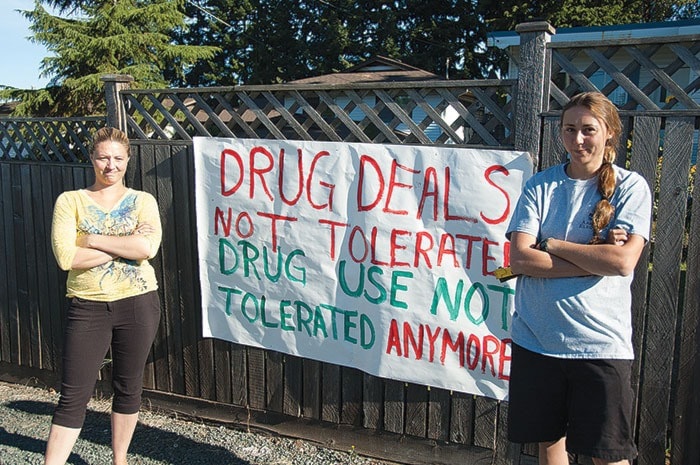Abby Morris says she has had enough of the needles and crack pipes that litter her yard on a regular basis.
She’s had enough of the drug deals that happen in front of her house and she’s had enough of having to be vigilant to make sure her son and his friends are safe as they play on their own property.
“I have compassion for these people, I really do,” she said Tuesday morning as she was putting up signs around her Evergreen property and on the lawns and fences of her neighbours, who are in support of her enterprise.
But when her six-year-old son is finding syringes in their carport, she said, that’s when it’s gone too far.
Her initiative was originally just to keep the Salvation Army shelter next door from changing their mandate and become a “low-barrier” shelter (one that doesn’t discriminate based on the intoxication levels of those seeking shelter) from its current “high-barrier” categorization (restricted to those who are clean at the time of assessment), but said since it isn’t managed like a high-barrier facility anyway, she and her neighbours just want it gone altogether.
“I’d like to find a solution,” Morris said. “I’ll even volunteer when they find a place for it, but that place isn’t here. The ‘alcohol and drug-free’ bit clearly isn’t happening.”
Niki Pye, whose son is friends with Morris’, was helping Morris put up her signs, and supports her goal, despite living in Willow Point, herself.
“I’ve seen the needles and the stuff in the backyard,” she said. “My kid plays in that backyard, too, so I’m all for [moving the shelter].”
According to the salvation Army’s Sean Junglas, who has been involved in the community consultation aspect of the shelter, they have been actively addressing concerns of those in the neighbourhood, such as adding garbage cans outside the property to prevent littering, and getting some windows locked.
“We have a very open format,” he said, in terms of neighbours being able to air complaints about the facility.
Junglas said he couldn’t confirm nor deny whether Morris’ complaints about blatant drug use on and around the property are true.
“I’m not aware of any drug use that’s been going on,” he said, but added that their intake is such that a full medical assessment of someone approaching them for shelter is not available, only an “observation” by intake personnel.
“When someone is found to be in that state [after they’ve been granted shelter], they are issued a restriction,” he said, meaning that they are then prohibited from sheltering in the facility for a set period of time.
Junglas said that they are currently in consultation not only with the community members and concerned neighbours, but have also hired a consulting company in cooperation with the city of Campbell River and the Campbell River Homelessness Coalition to find a solution to this issue. That consultation is expected to be completed by mid-September.
“We need to find a way to provide these services to the community,” he said, pointing out that addictions and mental health are two of the main contributing factors to homelessness and shelter needs in a community, and are therefore of utmost importance during the consultation and assessment process.
“It’s a challenge,” he said, “but we’re continuing to work with everyone involved to find a solution.”
As for Morris, she said although she’s sure her signs will be, “torn down in no time,” she isn’t going to be giving up anytime soon, and invites those who support the removal of the shelter from the community to contact her at abbymorris79@gmail.com or on her cell at 250-204-6111.
